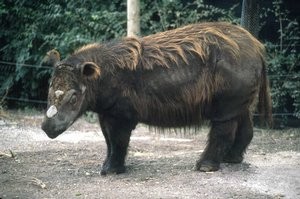
September 10, 2006

The Sumatran rhinoceros (above) is a special animal. In many ways, it retains several characteristics that link it to the megafauna of the Pleistocene. The Sumatran rhino thus is a living fossil*, related to the wooly rhinoceros (directly below) of the Ice Ages. That the Sumatran variety are still around is remarkable.
From Malaysia, September 2006, comes important news that overlaps nicely with this being the same part of the world that our attention has been directed to regarding the Johor Bigfoot. The first Sumatran rhino has been verified by scientists in the Borneo jungles.

The Bernama news service account of September 6th and other dispatches through the Associated Press of September 8th and 9th detail the findings:
Environmentalists in Sabah are buzzing with excitement. Years of patience was finally rewarded when they got a see a Sumatran rhino in its natural habitat on video. The video clip of the male Sumatran rhino was captured last week by a local ranger hired by Save Our Sumatran Rhino (SOS Rhino), a non-government organisation (NGO), during a daytime routine patrol in a forest reserve in the state (area details withheld to prevent poaching).
“This sighting and rare photos and video documenting the Sumatran rhino in its natural habitat is indeed very exciting. We have been tracking these animals here in Sabah for almost ten years now, and although we have seen tracks and signs of these rhinos, this is the first actual sighting of the endangered animal,” said Dr M.S Thayapara, the Program Officer for SOS Rhino Borneo.
According to him, the Sumatran rhino (Dicerorhinus sumatrensis) is the smallest of the five species of rhinos left in the world, and the only rhino species found in Malaysia and the most endangered of all five species.
Only about 50 Sumatran rhinos are left in Sabah.
According to the Associated Press:
Sabah is the last preserve of the Borneo Sumatran rhino, a subspecies of the Sumatran rhino, a bristly, snub-nosed, smaller version of the African variety. The subspecies has already become extinct in other parts of Borneo because of poaching. Borneo island is divided between Malaysia’s Sabah and Sarawak states, Indonesia’s Kalimantan province and the oil-rich sultanate of Borneo. Fewer than 300 rhinos of the second subspecies, the western Sumatran rhino, are believed to be living on Indonesia’s Sumatra island and mainland Malaysia. Hopes for the Borneo subspecies were boosted after Malaysian government wildlife officials and World Wildlife Fund experts found evidence of at least 13 of them in May last year. Rhino protection units have since launched patrols to deter poaching.
Thanks to Cryptomundo correspondent Matt Knapp for the tip to this developing story.
+++
*living fossil
“The Sumatran rhino, Dicerorhinus sumatrensis, is a very special animal. Probably fewer than four hundred existed the evening I met Emi, and the number has continued to drop. The Sumatran is also special because it is a living fossil. The genus to which it belongs originated at least thirty million years ago.” – E. O. Wilson, 2002.
Edward Osborne Wilson (b. June 10, 1929 in Birmingham, Alabama USA) is a distinguished biologist (entomology), researcher (sociobiology, biodiversity) and theorist (consilience, biophilia), a naturalist (conservationism), and a prominent man of letters. Wilson is known for his remarkably prolific career as a scientist, his advocacy for environmentalism, and his scientific humanist ideas concerned with religious, moral, and ethical matters. He is currently the Pellegrino Research Professor in Entomology for the Department of Organismic and Evolutionary Biology at Harvard University.
About Loren Coleman
Loren Coleman is one of the world’s leading cryptozoologists, some say “the” leading living cryptozoologist. Certainly, he is acknowledged as the current living American researcher and writer who has most popularized cryptozoology in the late 20th and early 21st centuries.
Starting his fieldwork and investigations in 1960, after traveling and trekking extensively in pursuit of cryptozoological mysteries, Coleman began writing to share his experiences in 1969. An honorary member of Ivan T. Sanderson’s Society for the Investigation of the Unexplained in the 1970s, Coleman has been bestowed with similar honorary memberships of the North Idaho College Cryptozoology Club in 1983, and in subsequent years, that of the British Columbia Scientific Cryptozoology Club, CryptoSafari International, and other international organizations. He was also a Life Member and Benefactor of the International Society of Cryptozoology (now-defunct).
Loren Coleman’s daily blog, as a member of the Cryptomundo Team, served as an ongoing avenue of communication for the ever-growing body of cryptozoo news from 2005 through 2013. He returned as an infrequent contributor beginning Halloween week of 2015.
Coleman is the founder in 2003, and current director of the International Cryptozoology Museum in Portland, Maine.
Filed under Breaking News, Cryptotourism, CryptoZoo News, Cryptozoologists, Cryptozoology, Eyewitness Accounts, Forensic Science, Malaysian Bigfoot